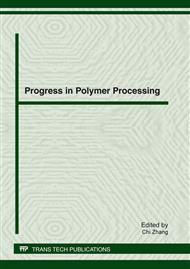p.253
p.259
p.263
p.269
p.274
p.279
p.283
p.289
p.294
Effects of Particle Size on the Rubber Mixing Process and Mechanical Properties of Compound
Abstract:
In order to improve the dispersion degree of carbon black and other additives, reduce consumption of energy and the temperature of discharging rubber compound, our research has been focused on preparation of rubber compound with different rubber particle size at filling coefficient of 0.6 and 0.7 in the mixer. The power consumption, the temperature of discharging rubber compound and the dispersion of carbon black were characterized in this study. The mechanical properties of the rubber compound have also been tested. The results indicate that reducing the particle size of rubber can reduce the consumption of energy and the temperature of discharging rubber compound and improve the mechanical properties, which is very important in rubber industry
Info:
Periodical:
Pages:
274-278
Citation:
Online since:
January 2012
Authors:
Keywords:
Price:
Сopyright:
© 2012 Trans Tech Publications Ltd. All Rights Reserved
Share:
Citation:


